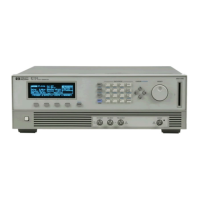5
c
6.
7.
8.
9.
10.
11.
m
Select the Delta t. menu and turn the T Markers On
n
Set START ON EDGE = PCS1 and STOP ON EDGE = POSI
n Press the (PRECISE EDGE FIND] key
RECORD the delta t reading. This is the rise time of the reference
signal
wit,hin
a 1% amplitude window of the signal connected to
Input. 4. This value is needed later to calculate the correct jitter.
(delta.t.up)
Select, the
Timebase
menu and center the second positive-going
edge of the signal (approximate Delay = 129 ns)
Press
INIORE)
and
(HISTOGRAM)
n
Select the Window submenu and set:
n
Source is channel 4
B
Choose the Time Histogram
n Press [WINDOW MARKER-I] and set it to 980
mV
w
Press [WINDOW MARKER
z]
and set it to 1 V
Select the Acquire submenu, set the Number of Samples to 1000
and press (START ACQUIRING‘)
After the data for the time histogram has been acquired (#
Samples =
lOO%),
select the Result submenu.
Press
INIEAN)
and (SIGMA). RECORD the value of sigma
The RMS-jitter is calculated as follows:
RMS
_
jitter
=
6sGma
-Flta.t.up
12. The RMS-jitter for period of 100 ns is 75 ps. Enter the result in
the Test Report as
TR
entry
5.1
- 1
13. Set the HP
8114A
period to 500 ns
14.
Repeat steps 6 to
11
Note
Iii
TIME/DIV = 200
ps/div;
approximate Delay = 530 ns
15. The RMS-jitter for period of 500 ns is 175 ps. Enter the result in
the Test Report as TR entry 5.1
-
2
Testing the HP
9114A
3.19

